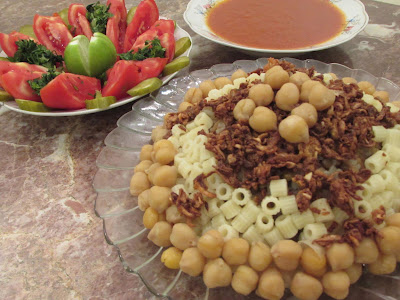4 similar foods between the Korean & Egyptian Cuisine
- January 31, 2019
- By Yostina Wasef
- 0 Comments
This article is coauthored with fellow honorary reporter Reem Molokhia
Despite the thousands of miles that keep South Korea
and Egypt apart, there is an interesting similarity between some foods in the Korean
and the Egyptian cuisine. Each carries the authentic unique taste of its country
and great traditions.
Speaking of which, first let’s talk about the savory
dishes:
1-
Korean Kim bap and Egyptian Mahshi:
Korean Kim bap:
 |
| Kim Bap - Photo by fellow honorary reporter Jap Vergonia |
Kim bap literally
means seaweed rice. Kim is a dried seaweed sheet and is sold ready for use. Kim
and steamed rice are the main ingredients to this dish. The Kim sheet is
stuffed with a layer of steamed rice in addition to some other ingredients that
are added according to personal taste. Mostly, these ingredients are seasoned
stir fried vegetables with fried eggs or just steamed vegetables along with
chili paste or powder.
Egyptian Mahshi:
|
|
|
Mahshi – Photos by
fellow honorary reporter Reem Molokhia
|
|
There are many kinds of Mahshi (stuffed
vegetables): Grape leaf Mahshi, Eggplant Mahshi, and Zucchini Mahshi to name a
few. The stuffing is also rice, however, the rice is not steamed but rather
stir fried along with red onions, tomato sauce, dill, parsley, and some spices
added to it but it’s not fully cooked at this stage. The grape leaves, eggplant,
or zucchini are then stuffed with that rice mixture and then are boiled till it’s
completely cooked.
2-
Korean Bi bim bap and Egyptian Koshari:
Korean Bi
bim bap:
 |
| Bi Bim Bap – Photo by fellow honorary reporter Reem Molokhia |
Bi bim bap is a mixture of cooked white
rice and seasoned stir fried vegetables. The vegetables are seasoned, julienned
and stir fried then placed on top of a bowl of rice individually next to each
other. Beef can also be added then a sunny side up fried egg is placed on top
along with hot chili pepper paste. Upon eating it, all the ingredients are mixed
together to create a savory mixture.
.
Egyptian Koshari:
 |
| Koshari – Photo by fellow honorary reporter Esraa Elzeiny |
Koshari is a mixture of rice, macaroni, noodle
pasta, chickpeas, and lentil. Each ingredient is boiled till it’s fully cooked
individually, then all ingredients are added together in a bowl; additionally, hot
tomato sauce, garlic and vinegar sauce can then be added to the dish, and
served.
As for desserts, we find that Korean and Egyptian desserts
are greatly similar in many ways.
3-
The Korean Yot and the Egyptian Asaliyya:
Korean Yot:
Korean Yot:
|
|
|
Korean Yot – Photo by Korea.net
|
|
The Korean Yot is
made from glutinous rice, steamed rice, corn, or sweet potato. For example ‘Sal
Yot – 쌀엿’ is made from rice. ‘Hobak Yot – 호박엿’ is made from pumpkin, and ‘Gae Yot – 깨엿’ is made from rice and covered with sesame. The garnish that covers the Yot varies. It can be covered with peanuts, sunflower
seeds, sesame, or pumpkin seeds.
Egyptian Asaliyya:
|
|
|
Egyptian Asaliyya – Photo by fellow honorary
reporter Bardise Eldeeb
|
|
The Egyptian Asaliyya
is made from molasses and dipped in sesame or peanuts or free from nuts.
The Egyptians have
known Asaliyya dessert for over a hundred years and is loved by both children and
adults. Its taste brings back memories of the golden days with each bite.
.
4-
Korean sesame dessert and
Egyptian peanut and sesame dessert:
And finally, the dessert that combines
between the Far East and the Middle East, these two are identical.
Korean Sesame and peanut dessert:
 |
| Korean seasmie and peanut desert – Photo by Korea.net |
In Korea, it’s called
‘깨강정– Kae kang jeong’. It’s a crispy dessert
made from sesame and peanuts along with sugar and corn syrup.
Egyptian Sesame and Peanut dessert:
|
|
|
Egyptian seasmie and Peanut desert – Photo by fellow
honorary reporter Bardise Eldeeb
|
|
Egyptian sesame and peanut
dessert is made from sesame and roasted peanuts in addition to sugar and lemon.
The final product is very similar to the Korean one.
It is notable that
both desserts are well known and are eaten on holidays and feasts. In Korea, the
sesame dessert is served in Lunar New Year’s eve and in ‘Chuseok – 추석’ the Korean thanksgiving. In Egypt the peanut and sesame dessert are popular
in the Prophet Muhammad’s birth anniversary (peace be upon him).












![The Goblin that took Korea by Storm [Korea.net Article]](https://blogger.googleusercontent.com/img/b/R29vZ2xl/AVvXsEgjARIwsdCb1r8uZTdDz1s-KOswTqBX-D4ljKK7ya50EuKJmXzA7CQ3PbY8Z7ZgHhdTTfiAWe8dTYejsr3hP8214ypI0lk2isOMjFWlRusYwfIgSVuCbhSCBE1T7ecB9Z2I6NwpoTyBtJLc/s72-c/goblin.jpg)

0 comments